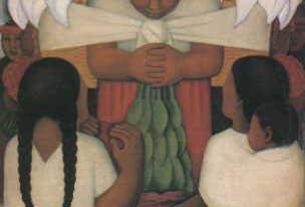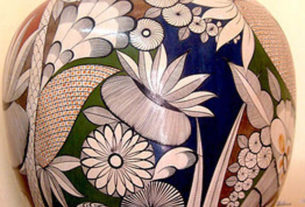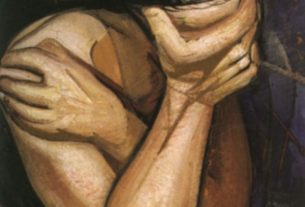Not a river exactly, Xochimilco is a vast system of canals and gardens at the southern extreme of this megalopolis called Mexico City. It was a lake at the time of the Aztecs. They floated rafts on the shallow lake´s surface and heaped them with rich soil and compost and grew enough produce on them to feed the entire city of Tenochtitlán, the biggest city in the world, then as now. Over the years the rafts, chinampas they are called, attached themselves to the lakebed and became rectangular islands. Now, centuries later, much of the lakebed has become city.
But Xochimilco, the “place of flowers,” remains to recall that amazing time in our city´s astounding youth. And it is still beautiful. Crops still grow in the rich soil of the chinampas. Ancient trees tower over the canals. Flowers are everywhere. Elephant ears the size of an actual elephant´s ears nod lazily alongside the water. Tiny houses that seem to have been thrown together from the newer city´s detritus and elegant homes with tile roofs and lavish lawns neighbor gracefully.
Neither electric nor combustion engines whine or roar in the waters of Xochimilco´s gardens. The almost-rural, near silence is only broken by the splashing sound of poles dipping into the placid waters to push wildly decorated little flat-bottomed boats up and down the canals. On weekends, they say, the little boats – they look like what my south Louisiana kinfolk would call pirogues – are so thick on the water their polers can barely maneuver them. And they are chock full of noisy revelers.
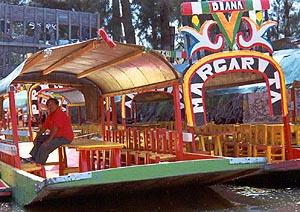
David and I chose a Monday for our Xochimilco trip. Most of the museums in our town take a well-earned breather on Mondays, so we chose an outing for our diversion. Neither of us had any idea what to expect really. Those guidebooks that list Xochimilco as a tourist destination rarely fail to mention that decent foreign tourists abandoned that place years ago due to the nastiness in the water caused by unmitigated urban sprawl. Our Lonely Planet guide says the water is cleaner since the 1980s, when people began to realize what a treasure was being despoiled.
Xochimilco isn´t exactly pristine now, but the floating plastic bottles seem to be at a relative minimum, and the somewhat murky water doesn´t smell nasty – unlike some bodies of water I know in this thirsty republic. The verdant vistas and the blessed quiet make up for any ecological unpleasantness anyway. Our poler dipped his hand down into the water at one point where a waterfall tumbled into the canal and picked up some as if to drink it, but wisely decided to just let the sparkling stuff sprinkle through his fingers and splash back into the canal. He explained that the water entering the canals is now treated. The fact there are no automobiles anywhere within the garden doubtless helps keep the water cleaner, too.
To get to Xochimilco we boarded the light rail train at the Tasqueña Metro station. The train is fast and comfortable and air-conditioned. It glides through parts of town we had never seen before, so we were delighted. The train never once dips down below the surface so the view is unimpeded. It only costs around fifteen cents for the forty-minute trip, and that is a bargain in anyone´s guidebook.
Upon arrival at the Embarcadero station in the village of Xochimilco, we both had the distinct impression that we were in a seacoast town. Maybe it´s the scruffiness of the place. Buildings are in want of paint and some façades have crumbled. But Xochimilco is a bustling village, with a huge market and a lively plaza. The walk through town from the train station to the embarcaderos was pleasant enough. At nearly every corner some polite gentleman or lady urged us on with helpful directions. It´s only about a four-block stroll.
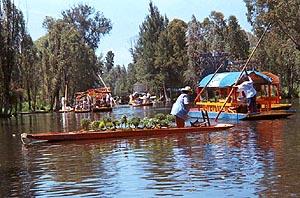
A number of embarcaderos invite the visitor, but we chose the first one in line. The sun was beginning to fry the hair on my already red neck. Next time I will bring a straw hat. An elderly gentleman urged us onto a trajinera (a pirogue) with the improbable name of Clementine (of “Oh, my darlin´” fame, I guess), saying the poler would take really good care of us and get us some ice-cold beer for the journey. We paid $150 pesos each for the three-hour voyage. It seemed higher than the sign at the embarcadero announced, but, as it turned out, it was well worth every centavo.
Clementine (and nearly every other trajinera on the waters of Xochimilco) is bedecked with an arco of painted flowers that emblazon the proud craft´s name. There are gaudy Margaritas and Dianas, elegant Esmeraldas and Flors, pert Penelopes, and bold Brígidas, as well as one or two Corona signs plastered on a trajinera´s metal canopy. Fernando, our earnest poler, unwedged his lovely boat from the hundreds moored at the dock, flipped back the arco with her name on it to avoid a low-slung bridge, and bumper-carred his way out of the narrow channel into the wide and sunny main canal.
Gradually, as we swayed lazily up the canal, the tall trees turned the blazing sun into gentle dapples, and the scent of flowers filled the air. The henceforth taciturn Fernando stopped once at a canal-side dock to pick us up some Negra Modelos. ” Bien frías,” he lied brightly, but never mind, they tasted like ambrosia to us.
We passed several dozy European-looking (you know, drab gray workshirts and faded jeans with split knees) couples returning from their own private voyages through this green wonderland. And then we came upon our first trajinera-load of mariachis. They struck up the band, as if to tempt us, and their leader shouted out, ” Canciones, caballeros? We can do ´Cielito Lindo´ or ´Llorar´ or ´Dos Arbolitos,´ you name it.” We thanked them for the kind offer, but declined due to a pretty serious lack of expendable funds. We had believed the guide books about the cost of the cruise. The mariachis relaxed back into their domino game.
A young Indian couple on a smaller, but just as brightly-colored boat poled up alongside us. She had a brazier full of glowing charcoal and a large metal comal within easy reach. Under glass, a half dozen naked-looking chicken halves waited to become tacos under her deft brown hand. A bouquet of flowers was twisted into the tail end of her long, black braid. He invited us sweetly to dine with them, but we declined again. “She makes the best tacos and mixiote in Xochimilco,” he assured us. “Very clean, too.” Their boat looked spotless, and I thought about the nostalgic tales of Frida and Diego on a weekend trajinera-cruise described in Guadalupe Rivera Marín´s fantastic cookbook, Las fiestas de Frida y Diego-Recuerdos y Recetas. Again, we had to refuse.
The handsome couple poled off to a shadier place at the edge of the canal, just as two, huge trajineras, lashed together and filled to overflowing with a noisy party of Germans (I heard one of them growl, ” Ja, ja, sehr gut!” as he pulled on a black cigar), lumbered into view. We toasted them with the remains of our Negras, but the Germans barged by us without acknowledging our good cheer. The Indian couple with the glowing brazier didn’t even offer their gustatory services. Way too many maws to satisfy with their meager flock of half chickens.
The no-longer floating gardens of Xochimilco grow a luxuriant variety of plants. Tall cypresses and ahuehuete trees line the canals, but behind them are cultivated gardens of flowering plants like bugambilia, cannas, day lilies, dahlias, as well as corn and beans and squash. There are viveros, nurseries, at every turn. One or two specialize in bonsai trees. An elderly woman in a wide-brimmed straw hat paddled her narrow canoa laden with fifteen or twenty of the diminutive trees out to greet us. ” Arbolitos, señores?” she smiled sweetly and temptingly. Again we declined.
To get to Xochimilco, take the blue line Metro to its southernmost station, Tasqueña. The light train station is in the same building.
Look for signs that say, ” Tren ligero.” Tickets are $1.50 pesos (at this writing in 2002) at the taquilla.
Hand your ticket to the guard at the turnstile instead of trying to stick it into the slot.
Get off the train at the last station, Embarcadero, not at the station named Xochimilco.
Walk the few blocks to the embarcaderos. You´ll have plenty of directional help from both Xochimilco citizens and signs.
“Too expensive anyway,” pronounced Fernándo, “no valen.” Whether they had been worth it or not made little difference to our nearly empty pockets.
“Want to tie up at this dockside restaurant?” asked Fernándo. It was time for lunch, and we were getting gnarly. “No, but thanks.”
We poled slowly off into an even quieter and shadier canal. I spied a sign saying the DF government had generously stocked the canals with carp of various sorts, and no one was to catch them until they´d had a chance to grow and fill the canals with finny offspring. An Indian man and his teenage son sat directly under the sign, and their cane poles leaned out over the green water. Reminded me of bygone days in southern Louisiana. Fernándo, from his post at Clementine´s stern, asked them if they´d caught anything. They had. Unlike in my own bygone days. (I never really wanted to catch anything, if truth were told.)
After two and a half hours, as David put it, the beers had “reduced us to contented slugs.” David mused on the fact that his great grandmother, Iola Boynton Everett, had also been boating at Xochimilco. In 1903.
“She sent a postcard back to Texas to her bachelor son, Mark Wilmot Everett, who was 24 and about to marry Meta Dorothea Limroth, daughter of German immigrants, and who together would someday become my grandparents. I know all of this because I am here and I have that postcard,” said David.
I had nothing but my fishing days to report, and they weren´t very romantic. We arrived back at the embarcadero, used most of our remaining pesos to tip Fernándo, who finally did smile, and wandered through the messy and charming little village of Xochimilco to the light train station. We herded onto the train with a throng of chatty commuters, and slid contentedly, drowsily back up the tracks toward the Centro and home.

